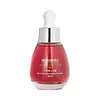What's inside
What's inside
 Key Ingredients
Key Ingredients

 Benefits
Benefits

 Concerns
Concerns

No concerns
 Ingredients Side-by-side
Ingredients Side-by-side

Rosa Centifolia Flower Water
Skin ConditioningGlycerin
HumectantHydrolyzed Collagen
EmollientNatto Gum
Wheat Amino Acids
Skin ConditioningPanax Ginseng Root Extract
EmollientOphiopogon Japonicus Root Extract
Skin ConditioningPlatycodon Grandiflorus Root Extract
AntioxidantGlycyrrhiza Glabra Root Extract
BleachingAstragalus Membranaceus Root Extract
EmollientZingiber Officinale Root Extract
MaskingLonicera Japonica Flower Extract
Skin ConditioningZanthoxylum Piperitum Fruit Extract
Skin ConditioningPulsatilla Koreana Extract
Skin ConditioningCitrus Paradisi Fruit Extract
Skin ConditioningSodium Hyaluronate
HumectantDioscorea Opposita Root Extract
Skin ConditioningHydroxyethylcellulose
Emulsion StabilisingGardenia Florida Oil
TonicTremella Fuciformis Sporocarp Extract
AntioxidantAcetyl Hexapeptide-8
HumectantXanthan Gum
EmulsifyingAdenosine
Skin ConditioningDisodium EDTA
Rosa Centifolia Flower Water, Glycerin, Hydrolyzed Collagen, Natto Gum, Wheat Amino Acids, Panax Ginseng Root Extract, Ophiopogon Japonicus Root Extract, Platycodon Grandiflorus Root Extract, Glycyrrhiza Glabra Root Extract, Astragalus Membranaceus Root Extract, Zingiber Officinale Root Extract, Lonicera Japonica Flower Extract, Zanthoxylum Piperitum Fruit Extract, Pulsatilla Koreana Extract, Citrus Paradisi Fruit Extract, Sodium Hyaluronate, Dioscorea Opposita Root Extract, Hydroxyethylcellulose, Gardenia Florida Oil, Tremella Fuciformis Sporocarp Extract, Acetyl Hexapeptide-8, Xanthan Gum, Adenosine, Disodium EDTA
Water
Skin ConditioningButylene Glycol
HumectantDipropylene Glycol
HumectantNiacinamide
SmoothingPropanediol
SolventGlycerin
HumectantCollagen Extract
Skin ConditioningAnastatica Hierochuntica Extract
Astringent1,2-Hexanediol
Skin ConditioningErythritol
HumectantPolyglyceryl-10 Laurate
Skin ConditioningHydroxyacetophenone
AntioxidantAdenosine
Skin ConditioningAcrylates/C10-30 Alkyl Acrylate Crosspolymer
Emulsion StabilisingDipotassium Glycyrrhizate
HumectantXanthan Gum
EmulsifyingEthylhexylglycerin
Skin ConditioningAllantoin
Skin ConditioningButyrospermum Parkii Butter
Skin ConditioningCaprylic/Capric Triglyceride
MaskingDisodium EDTA
Olea Europaea Fruit Oil
MaskingHydrogenated Lecithin
EmulsifyingSqualane
EmollientArginine
MaskingPanthenol
Skin ConditioningTrehalose
HumectantBifida Ferment Lysate
Skin ConditioningGlyceryl Acrylate/Acrylic Acid Copolymer
HumectantCichorium Intybus Root Extract
MaskingTaraxacum Officinale Rhizome/Root Extract
Skin ConditioningCeramide NP
Skin ConditioningCholesterol
EmollientSodium Hyaluronate
HumectantPhytosphingosine
Skin ConditioningHydroxypropyltrimonium Hyaluronate
Acetyl Hexapeptide-8
HumectantHydrolyzed Hyaluronic Acid
HumectantHexapeptide-9
Skin ConditioningNonapeptide-1
Skin ConditioningPalmitoyl Pentapeptide-4
Skin ConditioningPalmitoyl Tripeptide-1
Skin ConditioningPalmitoyl Tetrapeptide-7
Skin ConditioningSodium Acetylated Hyaluronate
HumectantHyaluronic Acid
HumectantHydrolyzed Sodium Hyaluronate
Skin ConditioningSodium Hyaluronate Crosspolymer
HumectantPotassium Hyaluronate
Skin ConditioningWater, Butylene Glycol, Dipropylene Glycol, Niacinamide, Propanediol, Glycerin, Collagen Extract, Anastatica Hierochuntica Extract, 1,2-Hexanediol, Erythritol, Polyglyceryl-10 Laurate, Hydroxyacetophenone, Adenosine, Acrylates/C10-30 Alkyl Acrylate Crosspolymer, Dipotassium Glycyrrhizate, Xanthan Gum, Ethylhexylglycerin, Allantoin, Butyrospermum Parkii Butter, Caprylic/Capric Triglyceride, Disodium EDTA, Olea Europaea Fruit Oil, Hydrogenated Lecithin, Squalane, Arginine, Panthenol, Trehalose, Bifida Ferment Lysate, Glyceryl Acrylate/Acrylic Acid Copolymer, Cichorium Intybus Root Extract, Taraxacum Officinale Rhizome/Root Extract, Ceramide NP, Cholesterol, Sodium Hyaluronate, Phytosphingosine, Hydroxypropyltrimonium Hyaluronate, Acetyl Hexapeptide-8, Hydrolyzed Hyaluronic Acid, Hexapeptide-9, Nonapeptide-1, Palmitoyl Pentapeptide-4, Palmitoyl Tripeptide-1, Palmitoyl Tetrapeptide-7, Sodium Acetylated Hyaluronate, Hyaluronic Acid, Hydrolyzed Sodium Hyaluronate, Sodium Hyaluronate Crosspolymer, Potassium Hyaluronate
 Reviews
Reviews

Alternatives
Ingredients Explained
These ingredients are found in both products.
Ingredients higher up in an ingredient list are typically present in a larger amount.
Acetyl Hexapeptide-8, commonly known as Argireline or Acetyl Hexapeptide-3, is a popular peptide in skincare. It’s often referred to as a “Botox-like” ingredient because it helps reduce muscle movement.
By relaxing these micro-movements, Argireline may help minimize the appearance of fine lines and wrinkles. That said, it’s not as powerful as Botox, and research on its long-term effectiveness is still limited.
Beyond smoothing, Argireline may also support collagen production. Collagen is the protein that helps keep your skin firm, bouncy, and well-hydrated by strengthening the skin barrier.
So while Argireline isn’t a miracle fix, it can be a helpful addition to a routine focused on both prevention and skin health.
Read more about other common types of peptides here:
Learn more about Acetyl Hexapeptide-8Adenosine is in every living organism. It is one of four components in nucleic acids that helps store our DNA.
Adenosine has many benefits when used. These benefits include hydrating the skin, smoothing skin, and reducing wrinkles. Once applied, adenosine increases collagen production. It also helps with improving firmness and tissue repair.
Studies have found adenosine may also help with wound healing.
In skincare products, Adenosine is usually derived from yeast.
Learn more about AdenosineDisodium EDTA plays a role in making products more stable by aiding other preservatives.
It is a chelating agent, meaning it neutralizes metal ions that may be found in a product.
Disodium EDTA is a salt of edetic acid and is found to be safe in cosmetic ingredients.
Learn more about Disodium EDTAGlycerin is already naturally found in your skin. It helps moisturize and protect your skin.
A study from 2016 found glycerin to be more effective as a humectant than AHAs and hyaluronic acid.
As a humectant, it helps the skin stay hydrated by pulling moisture to your skin. The low molecular weight of glycerin allows it to pull moisture into the deeper layers of your skin.
Hydrated skin improves your skin barrier; Your skin barrier helps protect against irritants and bacteria.
Glycerin has also been found to have antimicrobial and antiviral properties. Due to these properties, glycerin is often used in wound and burn treatments.
In cosmetics, glycerin is usually derived from plants such as soybean or palm. However, it can also be sourced from animals, such as tallow or animal fat.
This ingredient is organic, colorless, odorless, and non-toxic.
Glycerin is the name for this ingredient in American English. British English uses Glycerol/Glycerine.
Learn more about GlycerinSodium Hyaluronate is hyaluronic acid's salt form. It is commonly derived from the sodium salt of hyaluronic acid.
Like hyaluronic acid, it is great at holding water and acts as a humectant. This makes it a great skin hydrating ingredient.
Sodium Hyaluronate is naturally occurring in our bodies and is mostly found in eye fluid and joints.
These are some other common types of Hyaluronic Acid:
Learn more about Sodium HyaluronateXanthan gum is used as a stabilizer and thickener within cosmetic products. It helps give products a sticky, thick feeling - preventing them from being too runny.
On the technical side of things, xanthan gum is a polysaccharide - a combination consisting of multiple sugar molecules bonded together.
Xanthan gum is a pretty common and great ingredient. It is a natural, non-toxic, non-irritating ingredient that is also commonly used in food products.
Learn more about Xanthan Gum